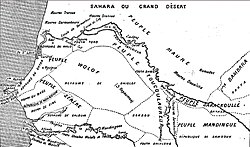Emirate of Trarza
| Emirate of Trarza | ||||||||
|
||||||||
|
The Senegal River area, 1853. Emirate of Trarza at upper left
|
||||||||
| Capital | Mederdra, Rosso | |||||||
| Government | Monarchy | |||||||
| Historical era | Early Modern Period | |||||||
| • | Confederation founded | 1640 | ||||||
| • | Declared a French protectorate | 1902 | ||||||
|
||||||||
The Emirate of Trarza was a precolonial state in what is today southwest Mauritania. It has survived as a traditional confederation of semi-nomadic peoples to the present day. Its name is shared with the modern Region of Trarza. The population, a mixture of Berber tribes, had been there for a long time before being conquered in the 11th century by Hassaniya Arabic speakers from the north. Europeans later called these people Moors/Maures, and thus have titled this group "the Trarza Moors".
Trarza, founded in the midst of the final wars between the local Berber Bedouins and the Arab conquerors of the Maghreb, was organized as a semi-nomadic state led by a Muslim prince, or emir. Trarza was one of three powerful emirates that controlled the northwest bank of the Senegal River from the 17th to the 19th centuries CE; the others were the emirates of Brakna, and the Tagant.
The Arab conquests had resulted in a society divided according to ethnicity and caste. The "warrior" lineages or clans, the Hassane, supposed descendants of the Beni Hassan Arab conquerors (cf. Oulad Delim) maintained supremacy and comprised the upper ranks. Below them were ranked the "scholarly" or "clerical" lineages, who preserved and taught Islam. These were called marabout (by the French) or zawiya tribes (cf. Oulad Tidrarine). The zawiya tribes were protected by Hassane overlords in exchange for their religious services and payment of the horma, a tributary tax of cattle or goods. While the zawiya were exploited in a sense, the relationship was often more or less symbiotic. Under both these groups, but still part of the Western Sahara society, were the znaga tribes, peoples who worked in lower caste occupations, such as fishermen (cf. Imraguen), as well as peripheral semi-tribal groups working in the same fields (among them the "professional" castes, mallemin and igawen). All these groups were considered to be among the bidan, or Arab whites.
...
Wikipedia

